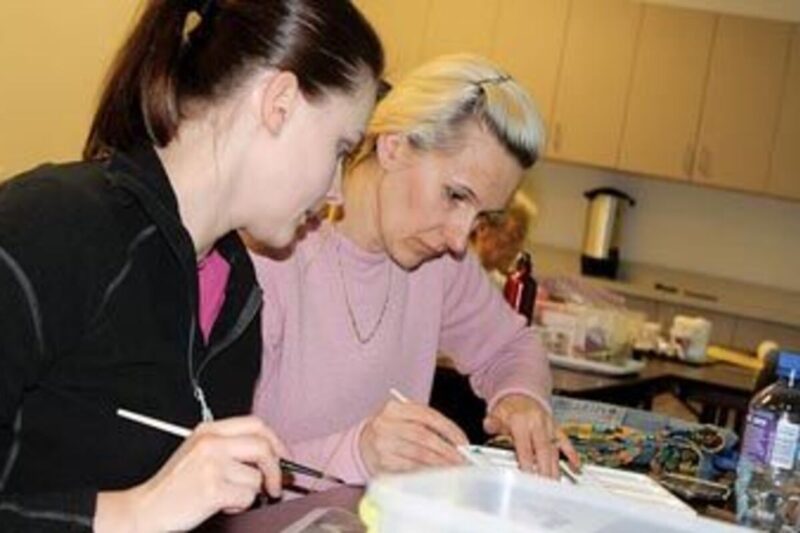Sean C. Morgan
Sweet Home teacher introduces students to the joys of watercolors
If you can make a mess, you can probably paint in watercolors.
With a little creative direction from a teacher like Lisa Chase, you’ll even manage to make it look good.
Chase teaches watercolors at the Linn-Benton Community College Sweet Home Center and her students are enthusiastic about their experience.
Behind her, the chalkboard shares a Ray Bradbury quote: “We are cups consistently and quietly being filled. The trick is knowing how to tip ourselves over and let the beautiful stuff out.”
Her students, about a dozen of them, have stacks of paintings they continue to work on as she introduces them to new techniques necessary to paint their subject: the aurora borealis.
It’s awesome,” says student Sasha McDonald, who is taking the class for the first time with her mother, Tanya Wright. “It’s really easy. A beginner could do it.”
Chase urges her students to observe how the water flows across the paper and interacts with the paint before it hits the tabletop.
It’s kind of fun to drop wet into wet,” she tells her class as she instructs them to all but drench their dark blue backgrounds in water, to tip them up and let water drain across the paper onto the tables, streaking the paper and making way for an aurora to appear while lightening the horizon.
There is no detail,” she says. “You don’t have to futz with it.”
The mess doesn’t matter either. Since this is watercolor paint, it cleans up easily with water.
I’m making a huge mess on this very, very expensive piece of equipment,” Chase says as she works at the overhead.
There is no wrong answer here,” she says drily. “If you hate it halfway through, you’re probably on the right track.”
Chase has been painting in watercolors since she owned and operated an art gallery. She started teaching watercolor at LBCC about three years ago.
I was offered the opportunity to teach,” Chase said. “I thought it would be a growing and learning experience for me as well as the people I come into contact with.”
Even her husband, Tim, a math-science type, has successfully painted in watercolors.
I have been very artistic and strange all my life,” Chase said. In 2000, she and Tim bought an art gallery. She was 19, and she bought herself a job where she could take her children. After four years, she felt she was good enough at painting to sell art.
She works in watercolors and acrylics, and she occasionally paints signs, though not commercially.
I painted in high school all the time,” Chase said of her days at Sweet Home High School. She later took college drawing classes at LBCC.
She cautioned that she doesn’t teach drawing and recommended that students take LBCC’s drawing classes.
She is fascinated by watercolors.
I like that you really kind of have to work with it,” Chase said. “And it has very few rules and lots of variables.”
An artist can use the same photo as a model two different times, she said. The colors and details will be different. During class, that’s because each class has different questions and ideas, which will lead to different approaches to a piece.
Watercolor is more of a conversation between you and hydrodynamics,” Chase said. How water flows is key to the art. As an artist, painting in watercolors is more like giving suggestions to the paper. She considers herself a catalyst.
Watercolor translates into real life lessons too, Chase said.
But she isn’t talking about the intangibles often associated with such a statement. She literally means that it translates into other areas, such as cooking or understanding how scents travel, which helps understand dogs.
Watercolor is literally one of those “how-things-work” things, she said. She enjoys making it “sciencey,” and for those science-brained folks, “I can totally help you out. Anybody can do it if you understand that gravity works and water flows downhill and there is a difference between white, black and gray.”
In her class, she is trying to provide some basic, foundational pieces for watercolor artists, Chase said. Sometimes, experienced artists, who naturally do what they do because it works, may be missing a basic technique or principle.
I don’t try to judge people,” Chase said. “I just try to tell them things I wish I knew when I started painting watercolors.”
Debi Cooley, who paints to relax, has been through four classes with Chase.
“It’s the techniques I’m into in that you can apply it to anything,” said Cooley, who is just getting back into oils, but enjoys watercolors. “It’s portable. I can take it anywhere.”
Chase usually doesn’t get to paint much in class, but outside of class, she paints custom pet portraits. She puts in about 12 hours per week during a medium week.
Thanksgiving to Christmas, she doesn’t want anyone talking to her, though, she said. That’s when she gets hammered painting pet portraits.
For details on custom pet commissions, contact Chase at [email protected].
For information on the class, call or sign up at the Lebanon or Sweet Home centers. The three classes she’ll teach in the spring at Brownsville, Sweet Home and Lebanon are in the catalog, and there is a senior discount.





